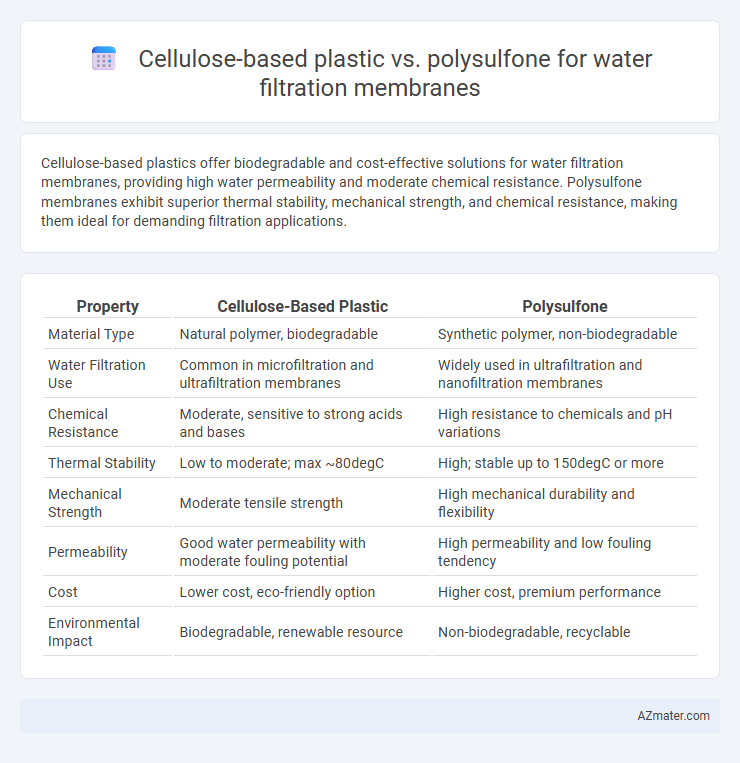Cellulose-based plastics offer biodegradable and cost-effective solutions for water filtration membranes, providing high water permeability and moderate chemical resistance. Polysulfone membranes exhibit superior thermal stability, mechanical strength, and chemical resistance, making them ideal for demanding filtration applications.
Table of Comparison
| Property | Cellulose-Based Plastic | Polysulfone |
|---|---|---|
| Material Type | Natural polymer, biodegradable | Synthetic polymer, non-biodegradable |
| Water Filtration Use | Common in microfiltration and ultrafiltration membranes | Widely used in ultrafiltration and nanofiltration membranes |
| Chemical Resistance | Moderate, sensitive to strong acids and bases | High resistance to chemicals and pH variations |
| Thermal Stability | Low to moderate; max ~80degC | High; stable up to 150degC or more |
| Mechanical Strength | Moderate tensile strength | High mechanical durability and flexibility |
| Permeability | Good water permeability with moderate fouling potential | High permeability and low fouling tendency |
| Cost | Lower cost, eco-friendly option | Higher cost, premium performance |
| Environmental Impact | Biodegradable, renewable resource | Non-biodegradable, recyclable |
Introduction to Water Filtration Membrane Materials
Cellulose-based plastics offer biodegradability and hydrophilicity, making them suitable for water filtration membranes that require high water permeability and fouling resistance. Polysulfone membranes provide superior chemical stability, thermal resistance, and mechanical strength, making them ideal for industrial water treatment under harsh conditions. Selection between cellulose-based and polysulfone membranes depends on specific filtration requirements such as operating pressure, pH tolerance, and contaminant type.
Overview of Cellulose-Based Plastics
Cellulose-based plastics, derived from renewable plant fibers, exhibit excellent biodegradability and high hydrophilicity, making them ideal for water filtration membranes. Their natural polymer structure allows for efficient moisture permeability and enhanced fouling resistance compared to synthetic counterparts like polysulfone. While polysulfone offers superior chemical stability and mechanical strength, cellulose-based membranes prioritize sustainability and environmental compatibility in filtration applications.
Overview of Polysulfone Membranes
Polysulfone membranes are widely utilized in water filtration due to their excellent thermal stability, high mechanical strength, and chemical resistance, outperforming cellulose-based plastics in harsh operating environments. These membranes offer superior permeability and selectivity, enabling efficient separation of contaminants such as bacteria, viruses, and organic compounds. The intrinsic hydrophobicity of polysulfone can be modified to enhance water flux and fouling resistance, making it a preferred material for ultrafiltration and microfiltration applications.
Key Filtration Mechanisms of Both Materials
Cellulose-based plastics utilize hydrophilic properties and micro-porous structures to enhance water permeability and enable effective size exclusion and adsorption of contaminants. Polysulfone membranes exhibit high chemical resistance and mechanical strength, facilitating filtration primarily through pore size control and molecular sieving for removing bacteria and suspended solids. Both materials employ different mechanisms where cellulose-based membranes rely more on adsorption and hydrophilicity, while polysulfone membranes depend on structural integrity and selective pore filtration.
Permeability and Filtration Efficiency Comparison
Cellulose-based plastic membranes exhibit moderate permeability with high filtration efficiency for removing suspended solids and organic compounds, making them suitable for general water filtration applications. Polysulfone membranes offer superior permeability due to their porous structure and higher chemical resistance, enabling faster water flow and enhanced removal of bacteria and viruses. The choice between cellulose-based plastic and polysulfone membranes depends on the water quality requirements, with polysulfone providing better filtration performance in demanding environments.
Chemical and Thermal Stability
Cellulose-based plastics exhibit moderate chemical resistance but are prone to degradation under harsh acidic or alkaline conditions, limiting their use in highly corrosive water filtration applications. Polysulfone membranes demonstrate superior chemical stability, maintaining integrity in aggressive pH environments and exposure to oxidants commonly found in water treatment processes. Thermal stability of polysulfone surpasses cellulose-based plastics, with polysulfone membranes tolerating continuous operation at temperatures up to 150degC, whereas cellulose-based membranes typically degrade above 80degC.
Mechanical Strength and Durability
Polysulfone membranes exhibit superior mechanical strength and durability compared to cellulose-based plastics, making them more resistant to pressure and physical damage in water filtration systems. Their robust polymer structure allows for longer operational life and better performance under harsh conditions, including high temperatures and chemical exposure. Cellulose-based membranes, while more biodegradable, tend to have lower tensile strength and are more prone to structural degradation over time, limiting their durability in demanding filtration applications.
Environmental Impact and Biodegradability
Cellulose-based plastics used in water filtration membranes exhibit high biodegradability and lower environmental impact due to their renewable origin and ability to decompose naturally in aquatic environments. Polysulfone membranes, while offering superior chemical and thermal resistance, present challenges in environmental sustainability because they are derived from non-renewable petrochemicals and degrade very slowly, contributing to persistent plastic pollution. The choice between cellulose-based and polysulfone membranes significantly influences the ecological footprint of water treatment processes, favoring cellulose-based materials for eco-friendly, biodegradable filtration solutions.
Cost and Scalability Considerations
Cellulose-based plastics offer lower initial material costs and are derived from renewable resources, making them more scalable for large-scale water filtration membrane production. Polysulfone membranes, while more expensive due to their synthetic polymer composition, provide superior chemical resistance and durability, which can offset higher upfront costs through longer service life and reduced replacement frequency. Cost-effectiveness and scalability decisions depend on balancing raw material expenses with performance requirements and application-specific operational conditions.
Future Trends and Innovations in Water Filtration Membranes
Cellulose-based plastics offer biodegradability and cost-effectiveness, driving future trends towards sustainable water filtration membranes, while polysulfone membranes excel in chemical resistance and mechanical strength, supporting innovations for long-lasting, high-performance filtration in industrial applications. Emerging research focuses on hybrid membranes combining cellulose's eco-friendly properties with polysulfone's durability to enhance filtration efficiency and reduce environmental impact. Advanced surface modifications and nanocomposite integrations in both materials aim to improve fouling resistance and selectivity, shaping the next generation of water purification technologies.

Infographic: Cellulose-based plastic vs Polysulfone for Water filtration membrane
 azmater.com
azmater.com